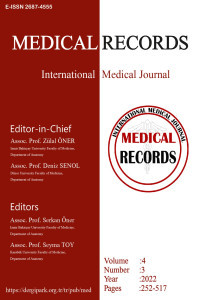Anxiety Status in Parents of Infants Referred During National Newborn Hearing Screening
Anxiety Status in Parents of Infants Referred During National Newborn Hearing Screening
___
- 1. Hahn M, Lamprecht-Dinnesen A, Heinecke A et al. Hearing screening in healthy newborns: feasibility of different methods with regard to test time. Int J Pediatr Otorhinolaryngol. 1999;51:83-9.
- 2. Thompson DC, McPhillips H, Davis RL et al. Universal newborn hearing screening: summary of evidence. JAMA. 2001;286:2000-10.
- 3. Yoon PJ, Price M, Gallagher K et al. The need for long-term audiologic follow-up of neonatal intensive care unit (NICU) graduates. Int J Pediatr Otorhinolaryngol. 2003;67:353–7.
- 4. Yoshinaga-Itano C. Benefits of early intervention for children with hearing loss. Otolaryngol Clin North Am. 1999;32:1089–102.
- 5. Hess M, Finckh-Krämer U, Bartsch M et al. Hearing screening in at-risk neonate cohort. Int J Pediatr Otorhinolaryngol. 1998;46:81–9.
- 6. Hille ET, van Straaten HI, Verkerk PH; Dutch NICU Neonatal Hearing Screening Working Group. Prevalence and independent risk factors for hearing loss in NICU infants. Acta Paediatr. 2007;96:1155–8.
- 7. World Health Organization. WHO global estimates on prevalence of hearing loss. Geneva; 2012. Available from: http://www.who.int/pbd/deafness/estimates accessed date 10 August 2022
- 8. World Health Organisation. Deafness and hearing impairment. 2008; Available at: http://www.who.int/mediacentre/factsheets/fs300/en/ index.html. accessed date August 10, 2022
- 9. Olusanya BO, Neumann KJ, Saunders JE. The global burden of disabling hearing impairment: a call to action, Bull. World Health Org. 2014;92:367e73.
- 10. Yoshinaga-Itano C, Sedey AL, Coulter DK, Mehl AL. Language of early and later-identified children with hearing loss. Pediatrics. 1998;102: 1161–71.
- 11. Uzcategui CA, Yoshinaga-Itano C. Parents’ reactions to newborn hearing screening. Audiol Today. 1997;9:24–7.
- 12. Beaula Vincy VK, Seethapathy J, Boominathan P. Parental anxiety towards ‘refer’ results in newborn hearing screening (NHS) in south India: A hospital based study. Int J Pediatr Otorhinolaryngol. 2019;116:25-9.
- 13. Tueller SJ, White KR. Maternal Anxiety Associated with Newborn Hearing Screening. Journal of Early Hearing Detection and Intervention. 2016;1:87-92.
- 14. Suppiej A, Cainelli E, De Benedittis M et al. Failure of hearing screening in high-risk neonates does not increase parental anxiety. J Matern Fetal Neonatal Med. 2013;26:932-5.
- 15. Joint Committee on Infant Hearing. Position statement 2007: principles and guidelines for early hearing detection and intervention programs. Pediatrics. 2007;120:898–21.
- 16. Mohd Khairi MD, Rafidah KN, Affizal A et al. Anxiety of the mothers with referred baby during Universal Newborn Hearing Screening. Int J Pediatr Otorhinolaryngol. 2011;75:513-7.
- 17. Crockett R, Wright AJ, Uus K et al. Maternal anxiety following newborn hearing screening: the moderating role of knowledge. J Med Screen. 2006;13:20-5.
- Yayın Aralığı: Yılda 3 Sayı
- Başlangıç: 2019
- Yayıncı: Zülal ÖNER
Adult Onset Langerhans Cell Histiocytosis: A Single Center Experience
Serhat ÇELİK, Zeynep Tuğba GÜVEN, Onur AŞIK, Muzaffer KEKLİK, Leylagül KAYNAR, Bülent ESER, Mustafa ÇETİN, Ali ÜNAL
Sacrum Kemiğinin Morfometrisi ve Varyasyonu
Gökçe BAĞCI UZUN, Merve AYDIN, Burcu KAMAŞAK, Büşra ZENCİRCİ, Tufan ULCAY, Mehtap NİSARİ, Hıdır PEKMEZ
Long-Term Results of Tragal Cartilage Type 1 Tympanoplasty
Fatih YÜCEDAĞ, Ergün SEVİL, İsmail ÇEVİK
Olcay ÖZDEMİR, Yağız ÖZBAY, Neslihan YILMAZ ÇIRAKOĞLU
Cerrahi Rezeksiyon Gerektiren Transvers Kolon Yerleşimli Pnömatozis Sistoides İntestinalis Olgusu
Recep BAYDEMİR, Duygu KURT GÖK
Perceived Stress and Hopelessness in COVID-19 Contacts
Mert KARTAL, Muhammet BAYRAKTAR
Orbitofrontal Cortex Volumes in Patients Diagnosed with Somatic Symptom Disorder
Burcu SIRLIER EMİR, Murad ATMACA, Aslı KAZĞAN KILIÇASLAN, Sevler YILDIZ, Hanefi YILDIRIM
Cemil ÇOLAK, Ahmet Kadir ARSLAN, Hasan UCUZAL, Adem KÖSE, İsmail Okan YILDIRIM, Emek GÜLDOĞAN, Mehmet Cengiz ÇOLAK
